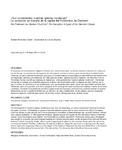Mostrar o rexistro simple do ítem
¿Son protestantes nuestras iglesias modernas?: la recepción en España de la capilla del Politécnico de Otaniemi
| dc.contributor.author | Fernández-Cobián, Esteban | |
| dc.date.accessioned | 2019-05-31T08:18:30Z | |
| dc.date.available | 2019-05-31T08:18:30Z | |
| dc.date.issued | 2017 | |
| dc.identifier.citation | Fernández-Cobián, E. (2018). ¿Son protestantes nuestras iglesias modernas?. Actas De Arquitectura Religiosa Contemporánea, 5, 66-85. https://doi.org/10.17979/aarc.2017.5.0.5143 | es_ES |
| dc.identifier.issn | 2340-5503 | |
| dc.identifier.uri | http://hdl.handle.net/2183/23100 | |
| dc.description.abstract | [Resumen] El desarrollo de la arquitectura religiosa moderna tuvo, desde el principio, un intenso carácter ecuménico en varios países de Europa. La construcción de espacios de culto pareció un buen comienzo para caminar hacia la unidad de los cristianos, ya que la petición de principio que llevó a la fundamentación arqueológica de estos edificios fue común entre los arquitectos católicos y los luteranos. En 1963 apareció el libro «Iglesias nuevas en España», del dominico Arsenio Fernández Arenas. Uno de sus capítulos se titulaba así: «¿Son protestantes nuestras iglesias modernas?». Fernández Arenas fue un teólogo que pretendía superar las lecturas más frecuentadas sobre el espacio de culto católico, por lo que el análisis de ese texto y de las arquitecturas a las que implícitamente alude, ofrece una oportunidad perfecta para reflexionar sobre el importante tema de la búsqueda de la convergencia entre confesiones cristianas a través de la forma construida. Tomando como punto de partida los argumentos allí expuestos, esta ponencia pretende explorar la sorprendente influencia de la capilla del Politécnico de Otaniemi, de Kaija y Heikki Siren, en las iglesias católicas españolas durante la segunda mitad del siglo pasado. El discurso acerca del despojamiento deviene crucial. | es_ES |
| dc.description.abstract | [Abstract] The development of modern religious architecture had, from the beginning, an intense ecumenical character in several European countries. The building of spaces of worship seemed a good start to move towards the unity of Christians, since the request of principle that led to the archaeological foundation of these buildings was common between Catholic and Lutheran architects. In 1963 appeared the book «Iglesias nuevas en España» by the Dominican Arsenio Fernández Arenas. One of its chapters was entitled: «Are Protestant our modern churches?». Fernandez Arenas was a theologian who sought to overcome the most frequent readings on Catholic worship space, so the analysis of this text and the architectures to which it implicitly alludes offers a perfect opportunity to reflect on the important theme about the search for convergence between Christian confessions through the built form. Taking this argument as a starting point, this paper tries to explore the surprising influence of the chapel of the Otaniemi Polytechnic by Kaija and Heikki Siren in the Spanish Catholic churches during the second half of the last century. The discourse about divestment becomes crucial. | es_ES |
| dc.language.iso | spa | es_ES |
| dc.publisher | Universidade da Coruña | es_ES |
| dc.relation.uri | https://doi.org/10.17979/aarc.2017.5.0.5143 | es_ES |
| dc.rights | Atribución-NoComercial 4.0 España | es_ES |
| dc.rights.uri | http://creativecommons.org/licenses/by-nc/3.0/es/ | * |
| dc.subject | Arquitectura religiosa | es_ES |
| dc.subject | Ecumenismo | es_ES |
| dc.subject | Arquitectura finlandesa | es_ES |
| dc.subject | Kaija y Heikki Siren | es_ES |
| dc.subject | Arsenio Fernández Arenas | es_ES |
| dc.subject | Religious architecture | es_ES |
| dc.subject | Ecumenism | es_ES |
| dc.subject | Finnish architecture | es_ES |
| dc.title | ¿Son protestantes nuestras iglesias modernas?: la recepción en España de la capilla del Politécnico de Otaniemi | es_ES |
| dc.title.alternative | Are Protestant our Modern Churches?: The Reception in Spain of the Otaniemi Chapel | es_ES |
| dc.type | info:eu-repo/semantics/article | es_ES |
| dc.rights.access | info:eu-repo/semantics/openAccess | es_ES |
| UDC.journalTitle | Actas de Arquitectura Religiosa Contemporánea | es_ES |
| UDC.volume | 5 | es_ES |
| UDC.startPage | 66 | es_ES |
| UDC.endPage | 85 | es_ES |






